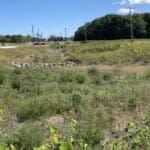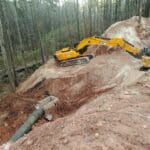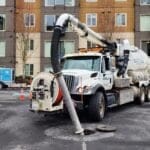City of St. Paul
The NPDES program was created in 1990 by the United States Environmental Protection Agency (EPA) to safeguard public waters through the regulation of the discharge of pollutants to surface waters including lakes, streams, wetlands, and rivers. The Minnesota Pollution Control Agency (MPCA) is the local authority responsible for administering this program. Under this program, specific permits are issued to regulate different types of municipal, construction, and industrial activities.
The MPCA issued the first Municipal Separate Storm Sewer System (MS4) NPDES Permit to the City of Saint Paul on December 1, 2000. The City’s MS4 Permit was reissued by the MPCA on January 21, 2011. This permit requires submittal of a revised Stormwater Management Program (SWMP). In 2012 and subsequent years, the report submittal date has been changed to June 30th.
The goal of the SWMP is to set a framework defining how the City will manage, operate, and maintain its Municipal Separate Storm Sewer System and areas within the City’s jurisdiction drained by the System in a manner to reduce the discharge of pollutants to the Maximum Extent Practicable (MEP). The stormwater management activities of the City cover a broad range of responsibilities involving the governing body and almost every department of the City. The City Council and Mayor approve budgets, ordinances, and policies to provide direction for the stormwater program.
Excerpt from St. Paul Stormwater Ordinance
Sec. 52.04. – Stormwater pollution control plan.
Any person, firm, sole proprietorship, partnership, corporation, state agency, or political subdivision proposing a construction activity of one (1) acre or more within the city shall submit a stormwater pollution control plan to the city for approval. No land shall be disturbed until the plan, conforming to the standards set forth herein, is approved by the city. At a minimum these pollution abatement control practices must conform to those in the current version of the MPCA’s publication, “Protecting Water Quality in Urban Areas” or other sources as defined in section 52.03(2).
(a) Minimum requirements of the stormwater pollution control plan:
(1) The name, address and telephone number of the following individuals:
a. Owner,
b. Applicant,
c. Person responsible for the preparation of the stormwater pollution control plan,
d. On-site person responsible for implementation, inspection and maintenance of the requirements of the stormwater pollution control plan,
e. Person responsible for the long term operation and maintenance of the permanent stormwater management system.
(2) A project description that includes the nature and purpose of the construction activity, the amount of grading, utilities, and building construction involved and the location of the project.
(3) Construction phasing that includes time frames and schedules for the project’s various aspects including erosion and sediment control practices.
(4) A map of the existing site conditions that includes existing topography, property information, steep slopes, existing drainage systems/patterns, type of soils, waterways, wetlands, vegetative cover and one hundred-year flood plain boundaries.
(5) A site construction plan that includes the location of the proposed construction activity and the plan for the maintenance and inspection of the stormwater pollution control measures, including the plan for disposal of collected sediment and floating debris.
(6) Location of temporary and permanent stormwater pollution control measures.
(7) Standard plates and/or specifications for all stormwater pollution control measures.
(8) Location of streams, lakes or wetlands which may be impacted by the construction activity.
(9) Provisions for preventing sediment damage to adjacent properties and other designated areas such as streams, wetlands and lakes.
(10) A plan to stabilize utility construction areas as soon as possible.
(11) A plan for permanent stabilization including how the site will be stabilized after construction is completed, including specifications and schedules.
(12) A plan for removal of temporary erosion and sediment control measures at the end of the project.
(13) Calculations that were made for the design of such items as rate control, sediment basins, wet detention basins, diversions, waterways, infiltration zones and other applicable practices.
(b) Minimum stormwater pollution control measures. These minimum control measures are required where bare soil is exposed. Where additional control measures are needed, they will be specified at the discretion of the city.
(1) All stormwater pollution control plans must be reviewed by the city for the effectiveness of erosion control measures in the context of site topography and drainage.
(2) Sediment control measures must be properly installed by the builder before the construction activity begins. Such structures may be adjusted during dry weather to accommodate short term activities, such as those that require the passage of very large vehicles. As soon as this activity is finished or before rainfall, the erosion and sediment control structures must be returned to the original configuration.
(3) Divert channeled runoff around disturbed areas and protect the channel.
(4) If a stormwater management plan involves directing some or all of the site’s runoff to adjacent property, the applicant or his designated representative shall obtain from adjacent property owners any necessary easements or other property interests concerning the flowing of such water.
(5) Scheduling the site’s activities to lessen their impact on erosion and sediment creation, so as to minimize the amount of exposed soil.
(6) Control stormwater runoff as follows:
a. All exposed soil areas with a continuous positive slope within two hundred (200) lineal feet of a surface water, must have temporary erosion protection or permanent cover for the exposed soil areas, according to the following table of slopes and time frames:
| Type of Slope |
Time* |
| Steeper than 3:1 |
7 days |
| 10:1 to 3:1 |
14 days |
| Flatter than 10:1 |
21 days |
* Maximum time an area can remain open when the area is not actively being worked.
These areas include pond side slopes, and any exposed soil areas with a positive slope to a stormwater conveyance system, such as a curb and gutter system, storm sewer inlet, temporary or permanent drainage ditch or other natural or man made systems that discharge to a surface water.
b. Install erosion and sediment controls at locations specified in the stormwater management plan. Minimum requirements include silt fences, rock check dams, or other equivalent control measures along slopes. Silt fences are required along channel edges to reduce sediment reaching channel. Silt fences, rock check dams, etc. must be regularly inspected and maintained.
c. The work shall conform to the current version of the MPCA’s publication, “Protecting Water Quality in Urban Areas,” and the current requirements found in the same agency’s NPDES/SDS permits for stormwater associated with construction activities.
(7) Silt fence shall be required to hold all sheet flow runoff generated at an individual site, until it can either infiltrate or seep through silt fence’s pores.
(8) Temporary soil stockpiles must have silt fence or other effective sediment controls, and cannot be placed in surface waters, including stormwater conveyances such as curb and gutter systems, or conduits and ditches.
(9) Temporary rock construction entrances are required wherever vehicles enter and exit a site.
(10) Streets must be cleaned and swept whenever tracking of sediments occurs and before sites are left idle for weekends and holidays. A regular sweeping schedule shall be established.
(11) Water (impacted by the construction activity) removed from the site by pumping must be treated by temporary sedimentation basins, geotextile filters, grit chambers, sand filters, up-flow chambers, hydro-cyclones, swirl concentrators or other appropriate controls. Such water shall not be discharged in a manner that causes erosion or flooding of the site, receiving channels, adjacent property or a wetland.
(12) All storm drain inlets must be protected during construction until control measures are in place with either silt fence or an equivalent.
(c) Stormwater Runoff Rate Control Stormwater runoff rate control is required for sites larger than one-quarter (¼) of an acre which go through the city’s site plan review process. Stormwater discharge into public storm sewers shall be controlled, in accordance with the department of public works policy. Required information to be submitted as part of the stormwater pollution control plan is available in a handout from the department of public works. Peak stormwater discharge rates from the site for all storms up to and including the critical 100-year frequency will not exceed:
Q = 1.64 × A
where Q = the maximum acceptable discharge rate in cubic feet per second and A = the site area in acres.
Discharge of all stormwater runoff and surface water shall be in a fashion so as to preclude drainage onto adjacent property or toward buildings.
(d) Flood control for buildings The low floor elevation for new construction must be a minimum of one (1) foot above the critical one hundred-year flood elevation and at least four (4) feet above normal groundwater elevation.
(e) Temporary Sediment Basins For common drainage locations that serve an area with ten (10) or more acres disturbed at one (1) time, a temporary (or permanent) sediment basin must be provided prior to the runoff leaving the construction site or entering surface waters. In addition to this requirement, the applicant is encouraged to install temporary sediment basins where appropriate in areas with steep slopes or highly erodible soils even if less than ten (10) acres drains to one (1) area. The basins must be designed and constructed in accordance with the current version of the MPCA’s general permit to discharge stormwater associated with construction activity under the NPDES.
(f) Permanent stormwater pollution controls.
(1) Where a project’s ultimate development replaces vegetation and/or other pervious surfaces with one (1) or more acres of cumulative impervious surface, a water quality volume of one-half (½) inch of runoff from the new impervious surfaces created by the project must be treated in one (1) of the following ways prior to the runoff leaving the site or entering surface waters (excluding drainage systems that convey stormwater to a constructed permanent stormwater management facility designed to treat the water quality volume from the project): wet sedimentation basin, infiltration/filtration, regional ponds, a combination of practices, or alternate methods in accordance with the current version of the MPCA’s general permit to discharge stormwater associated with construction activity under the NPDES.
(2) At a minimum these facilities must conform to the most current technology as reflected in the current version of the MPCA’s publication “Protecting Water Quality in Urban Areas” or other sources as defined in section 52.03 and the current requirements found in the same agency’s NPDES permits for stormwater associated with construction activities.
(3) Permanent stormwater pollution controls to be designed by a professional engineer licensed in the state. Constructed controls must be certified by a professional engineer as required in section 52.04(g)(3).
(g) Models/methodologies/computations. Hydrologic models and design methodologies used for the determining runoff characteristics and analyzing stormwater management structures must be approved by the city. Plans, specifications and computations for stormwater management facilities submitted for review must be sealed and signed by a licensed professional engineer. All computations must appear in the plans submitted for review, unless otherwise approved by the city.
(h) Inspection and maintenance of the stormwater pollution control plan’s measures.
(1) The applicant must routinely inspect the construction site once every seven (7) days during active construction and within twenty-four (24) hours after a storm event greater than one-quarter (0.25) inches in twenty-four (24) hours.
(2) The city’s inspection staff is authorized to perform inspection and enforce provisions of this article as may be required, to ensure that erosion and sediment control measures are properly installed and maintained. If the applicant fails to maintain proper erosion control measures on site and/or perform necessary remedial action, as directed by the inspector, the inspector may take such enforcement action as may be required to achieve compliance. Enforcement may be, but is not limited to, stopping all construction work at the site, until necessary remedial actions have been completed and erosion and sediment controls are in compliance with the approved plans.
(3) For sites that require permanent stormwater pollution controls, a certification letter shall be submitted after the facilities have been installed to affirm that construction has been completed in accordance with the approved stormwater pollution control plan. At a minimum, certification shall include a set of as-built drawings comparing the approved stormwater management plan with what was constructed. Other information shall be submitted as required by the approving agency.
(4) It shall be the responsibility of the applicant to obtain any necessary easements or other property interests to allow access to the stormwater management facilities for inspection and maintenance purposes.
(5) All stormwater pollution control management facilities must be designed to minimize the need of maintenance, to provide easy vehicle and personnel access for maintenance purposes and be structurally sound. These facilities must have a plan of operation and maintenance that ensures continued effective removal of the pollutants carried in stormwater runoff.
(C.F. No. 04-267, § 1, 4-7-04)
Sec. 52.05. – Review.
The city shall review the stormwater pollution control plan pursuant to the provisions of Minnesota Statute Sec. 15.99.
(C.F. No. 04-267, § 1, 4-7-04)
Sec. 52.06. – Modification of plan.
An approved stormwater pollution control plan may be modified upon submission of a written application for modification to the city, and after written approval by the city. In reviewing such an application, the city may require additional reports and data.
(C.F. No. 04-267, § 1, 4-7-04)
Sec. 52.07. – Financial securities.
The city may require financial security, in the form of either bond, letter of credit or cash escrow, for the performance of the work described in the approved stormwater pollution control plan and any related remedial work. This security must be available prior to commencing the project.
(a) Action against the financial security. The city may act against the financial security if any of the conditions listed below exist. The city shall use funds from this security to finance any corrective or remedial work undertaken by the city or a contractor under contract to the city and to reimburse the city for all direct cost incurred in the process of remedial work including, but not limited to, staff time and attorneys’ fees.
(1) The applicant ceases construction activities and/or filling and abandons the work site prior to completion of the stormwater pollution control plan.
(2) The applicant fails to conform to the stormwater pollution control plan as approved by the city, or to related supplementary instructions.
(3) The techniques utilized under the stormwater pollution control plan fail within one (1) year of installation.
(4) The applicant fails to reimburse the city for corrective action taken under section 52.08.
(5) Emergency action is taken under section 52.08.
(b) Returning the financial security. Any unspent amount of the financial security deposited with the city for faithful performance of the stormwater pollution control plan and any stormwater and pollution control plan related remedial work must be released not more than one (1) full year after the completion of the installation of all such measures and the establishment of final stabilization.
(C.F. No. 04-267, § 1, 4-7-04)
Sec. 52.08. – Failure of the stormwater pollution control plan.
(a) Notification by the city. The city shall notify the applicant, when the City has determined that any of the conditions set forth in 52.07(a) exist. The initial contact will be to the party or parties listed on the stormwater pollution control plan as contacts. Except during an emergency action, the city at its discretion may begin corrective work forty-eight (48) hours after notification by the city. Such notification should be in writing, but if it is verbal, a written notification should follow as quickly as practical. If after making a good faith effort to notify the responsible party or parties, the city has been unable to establish contact, the city may proceed with corrective work.
(b) Emergency action. If circumstances exist that pose an immediate danger to the public health, safety and welfare, the city, upon making this determination, may take immediate action to abate said circumstances for the purpose of restoring the site to a safe condition. The city shall, as part of this action, make reasonable effort to contact and give notice to the applicant of the decision to institute this emergency procedure. Any cost to the city associated with this emergency action is recoverable from the applicant or the applicant’s financial security.
(c) Erosion off-site. If erosion breaches the perimeter of the site, the applicant shall immediately develop a cleanup and restoration plan, obtain the right-of-entry from the adjoining property owner, and implement the cleanup and restoration plan within forty-eight (48) hours of obtaining the adjoining property owner’s permission. In no case, unless written approval is received from the city, shall more than seven (7) calendar days go by without corrective action being taken. If, in the discretion of the city, the applicant does not repair the damage caused by the erosion, the city may do the remedial work required and charge the cost to the applicant.
(d) Erosion into streets, right-of-ways, wetlands or water bodies. If eroded soils (including tracked soils from construction activities) enter or appear likely to enter streets, right-of-ways, wetlands, or other water bodies, prevention strategies, cleanup and repair must be immediate. The applicant shall provide all traffic control and flagging required to protect the traveling public during the cleanup operations and secure required right-of-way permits from the department of public works.
(e) Failure to do corrective work. When an applicant fails to conform to any provision of sections 52.07 or 52.08 within the time stipulated, the city may take the following actions:
(1) Withhold the scheduling of inspections and/or the issuance of a certificate of occupancy.
(2) Revoke any permit issued by the city to the applicant for the site in question.
(3) Direct the correction of the deficiency by city forces or by a separate contract.
(4) All costs incurred by the city in correcting stormwater pollution control deficiencies must be reimbursed by the applicant. If payment is not made within thirty (30) days after costs are incurred by the city, payment will be made from the applicant’s financial securities as described in section 52.07.
(5) If a financial security as described in section 52.07 was not required by the city, or if there is an insufficient financial amount in the applicant’s financial securities to cover the costs incurred by the city, then the city in its discretion is authorized to either certify the remaining amount to the property taxes or to assess the remaining amount against the property.
(C.F. No. 04-267, § 1, 4-7-04)
Sec. 52.09. – Enforcement.
The city shall be responsible for enforcing this chapter. Any person, firm, or corporation failing to comply with or violating any of these regulations, shall be deemed guilty of a misdemeanor and be subject to a fine or imprisonment or both. All land use and building permits must be suspended until the applicant has corrected the violation. Each day that a separate violation exists shall constitute a separate offense.
(C.F. No. 04-267, § 1, 4-7-04)
Sec. 52.10. – Right of entry and inspection.
The applicant shall allow the city and their authorized representatives, upon presentation of credentials to:
(a) Enter upon the permitted site for the purpose of obtaining information, examining records, conducting investigations or surveys or for the purpose of correcting deficiencies in stormwater pollution control.
(b) Bring such equipment upon the permitted site as is necessary.
(c) Examine and copy any books, papers, records, or memoranda pertaining to activities or records required to be kept under the terms and conditions of this permitted site.
(d) Inspect the stormwater pollution control measures.
(e) Sample and monitor any items or activities pertaining to stormwater pollution control measures.
(C.F. No. 04-267, § 1, 4-7-04)
Sec. 52.11. – Record retention.
The stormwater pollution control plan and all changes to it must be kept at the site during construction. The applicant must keep the stormwater pollution control plan, along with the following additional records, on file for three (3) years after completion of the construction project:
(a) Any other permits required for the project;
(b) Records of all inspections and maintenance conducted during construction;
(c) All permanent operation and maintenance agreements that have been implemented, including all right-of-way, contracts, covenants and other binding requirements regarding perpetual maintenance and;
(d) All required calculations for design of the temporary and permanent stormwater management systems.
(C.F. No. 04-267, § 1, 4-7-04)
Sec. 52.12. – Abrogation and greater restrictions.
This chapter is not intended to repeal, abrogate, or impair any existing easements, covenants, or deed restrictions. However, where this chapter imposes greater restrictions, the provisions of this chapter shall prevail.
(C.F. No. 04-267, § 1, 4-7-04)
Sec. 52.13. – Other statutes, rules and ordinances.
The applicant shall comply with all federal and state statutes and local ordinances including the current version of the MPCA’s general permit to discharge stormwater associated with construction activity under the NPDES and the requirements of the applicable watershed district or watershed management organization.
(C.F. No. 04-267, § 1, 4-7-04)
Sec. 52.14. – Severability.
The provisions of this chapter are severable, and if any provisions of this chapter, or application of any provisions of this chapter to any circumstance, are held invalid, the application of such provisions to other circumstances and the remainder of this chapter shall not be affected.
Link to City Stormwater Management Plan
City of South St. Paul 2012 Comprehensive Stormwater Management Plan
Saint Paul’s Watershed Management Organizations A watershed district is a special purpose unit of local government. Its area is based on watershed boundaries and its purpose is to manage water resources. By managing water resources on a watershed basis, communities can better work together to prevent and correct such problems as flooding, polluted lakes, and eroding stream banks.
Links to Watershed Districts and Organizations
Capitol Region Watershed District
Lower Mississippi River Watershed Management Organization
Mississippi River Watershed Management Organization
Ramsey-Washington Metro Watershed District
 Kenosha, Wis. Highway KR Regenerative Stormwater ConveyanceThe Root-Pike Watershed Initiative Network Kenosha County, and others worked with AQUALIS to design and implement an innovative solution for stormwater control along Highway KR.
Kenosha, Wis. Highway KR Regenerative Stormwater ConveyanceThe Root-Pike Watershed Initiative Network Kenosha County, and others worked with AQUALIS to design and implement an innovative solution for stormwater control along Highway KR. Durham, N.C. Sinkhole Leads to Stormwater System RehabilitationThe tenant on this property noticed a depression that opened to the ground below and notified the property owners.
Durham, N.C. Sinkhole Leads to Stormwater System RehabilitationThe tenant on this property noticed a depression that opened to the ground below and notified the property owners.
